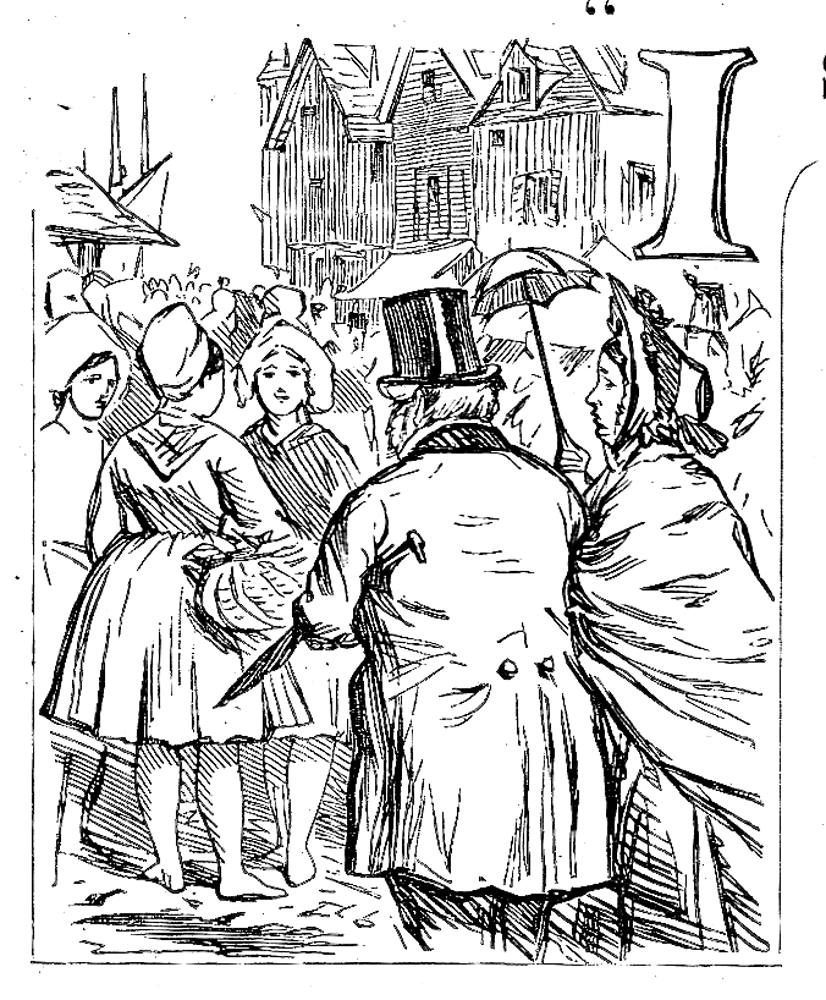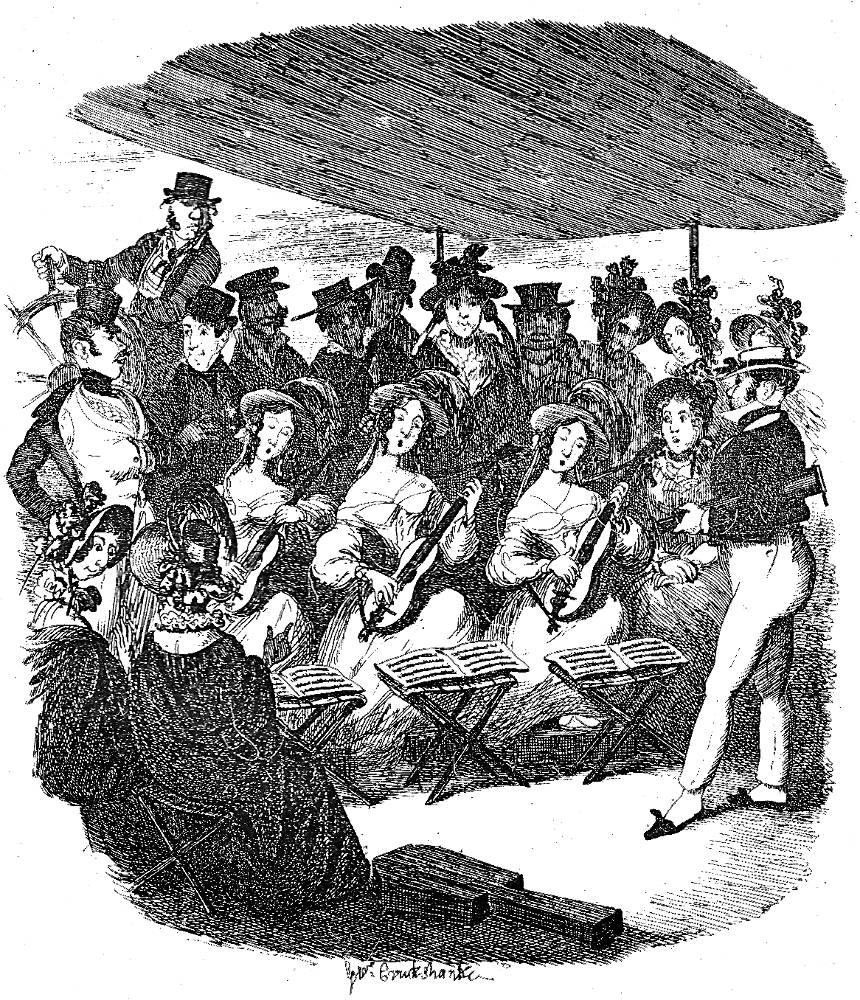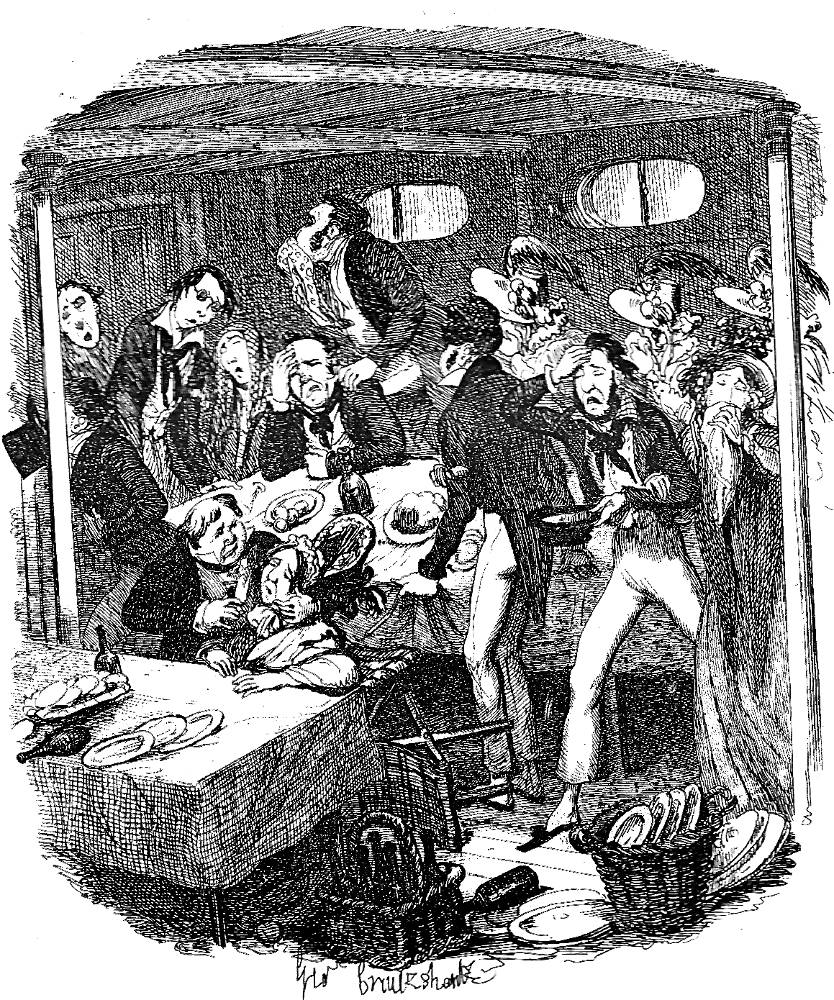

Mr. Caudle admires the Fish-women, Initial "I" —; initial-letter vignette for "The Twenty-Sixth Lecture" in Mrs. Caudle's Curtain Lectures, first published in the Punch; or, The London Charivari number for 2 August 1845 instalment, "Mrs. Caudle's first night in France —; 'Shameful Indifference' of Caudle at the Boulogne Custom House." Wood-engraving, 6.4 cm high by 5.1 cm wide, framed, p. 131. Forty-second illustration in the third edition. As Margaret Caudle regards the bare-legged fish-girls in the marketplace of the French port noted for its herring catch, Mr. Caudle considers the exorbitant prices being charged for French lace. Little does he think that his wife is planning to become a smuggler!
Scanned image and text by Philip V. Allingham. [You may use this image without prior permission for any scholarly or educational purpose as long as you (1) credit the person who scanned the image and (2) link your document to this URL.]
Passage Illustrated
"And a pretty place you have brought me to! A most respectable place, I must say! Where the women walk about without any bonnets to their heads, and the fish-girls with their bare legs —; well, you don't catch me eating any fish while I'm here. Why not? Why not, —; do you think I'd encourage people of that sort? What do you say? Good-night? [Lecture XXVI, "Mrs. Caudle's first night in France —; 'Shameful Indifference' of Caudle at the Boulogne Custom House," p. 135]
Commentary
The arrival at Margate of the much-reviled, attractive Miss Prettyman seems to have triggered Mrs. Caudle's desire to visit France, or more accurately, one of the popular French "watering-places" immediately across the Channel, Boulogne-sur-Merin the Pas-de-Calais, only thirty-one miles from Folkestone on the English side.The General Steamship Navigation Company from the 1820s offered just a passenger service, its most popular run being London to Margate. It added regular services between London, Hamburg, Rotterdam, Antwerp, Ostend, Calais, Boulogne, Lisbon, and Gibraltar, and from Brighton to Le Havre and Dieppe. By August 1825, the GSN was operating a fleet of fifteen steamships built at Deptford on the Thames. By 1833 the company was carrying mails and thousands passengers every week from London to Hamburg, Ostend, Boulogne, and Rotterdam.
Mrs. Caudle complains about the bare legs of the fish-girls, about the French language, about the behaviour of the Custom House officials, and even about the French lock on their bedroom door. She seems to forget that she demanded that her husband bring her to this "barbarous country" (135). However, she makes the best of her situation by shopping for French lace in the marketplace:
I afterwards," writes Caudle, "found out to my cost wherefore she inquired about lace. For she went out in the morning with the landlady to buy a veil, giving only four pounds for what she could have bought in England for forty shillings!"[136]
George Cruikshank's Complementary Steel-engravings for "The Steam Excursion" (1839)


Above: Cruikshank's realisation of the "before" and "after" scenes on board the Gravesend steamer, "The Steam Excursion," Part 1 and "The Steam Excursion," Part 2 (1839), the latter depicting the less-than-hilarious effects of sea-sickness. [Click on image to enlarge it.]
Related Material on Leisure
- The Development of Leisure in Britain, 1700-1850
- The Development of Leisure in Britain after 1850
- Technology and Leisure in Britain after 1850
Victorian Seaside Resorts
- Blackpool
- Bognor, East Parade
- Brighton (sitemap)
- Broadstairs, Kent
- Herne Bay
- Ramsgate
- Scarborough
- The Isle of Thanet, Kent
- Whitley Bay, North Tyneside
Bibliography
Jerrold, Douglas. Mrs. Caudle's Curtain Lectures, as Suffered by the late Job Caudle.Edited from the Original MSS. by Douglas Jerrold. With a frontispiece by Leech, and as motto on the title-page, "Then, Pistol, lay thy head in Fury's lap. —; Shakespeare." London: PunchOffice; Bradbury and Evans, 1846.
Jerrold, Douglas. Mrs. Caudle's Curtain Lectures. Illustrated by John Leach and Richard Doyle. London: Bradbury and Evans, 1856.
Jerrold, Douglas. Mrs. Caudle's Curtain Lectures. Illustrated by Charles Keene. London: Bradbury and Evans, 1866.
Last modified 16 December 2017